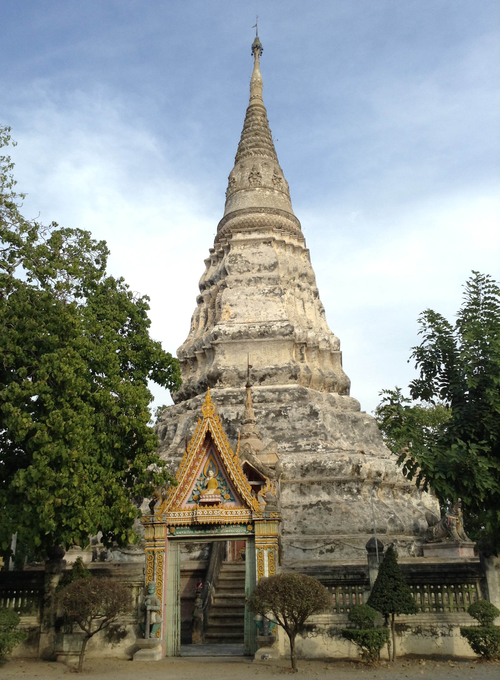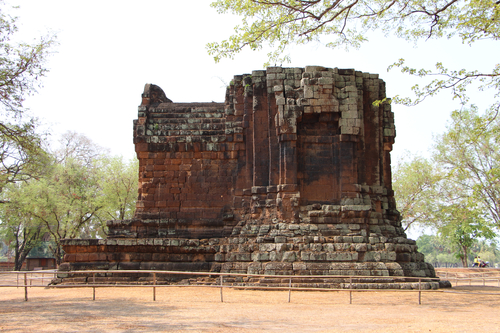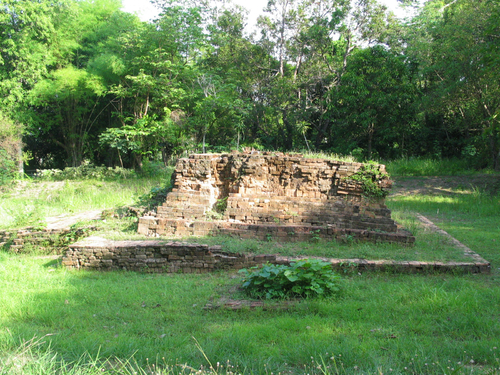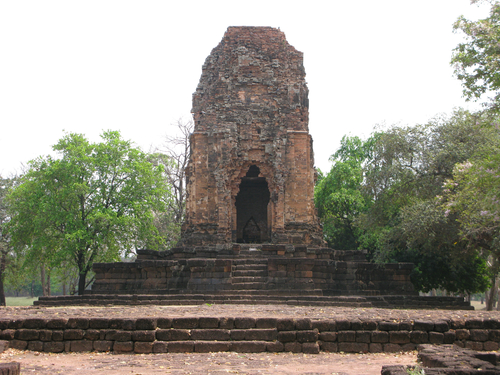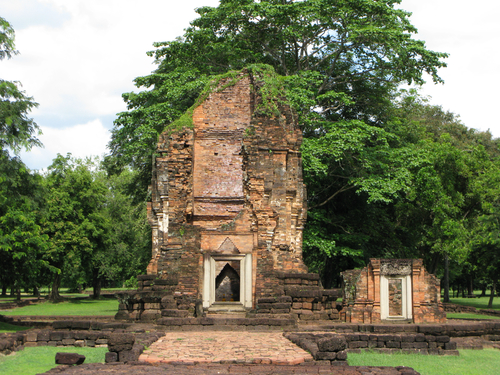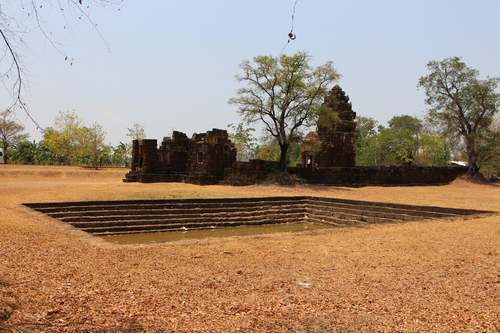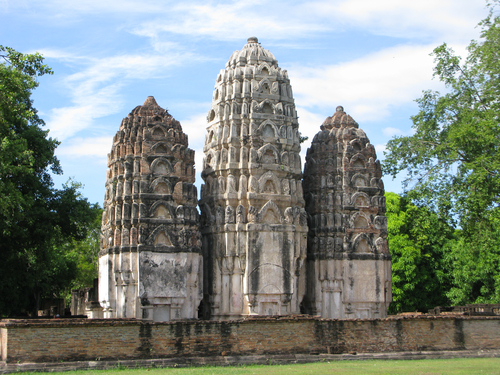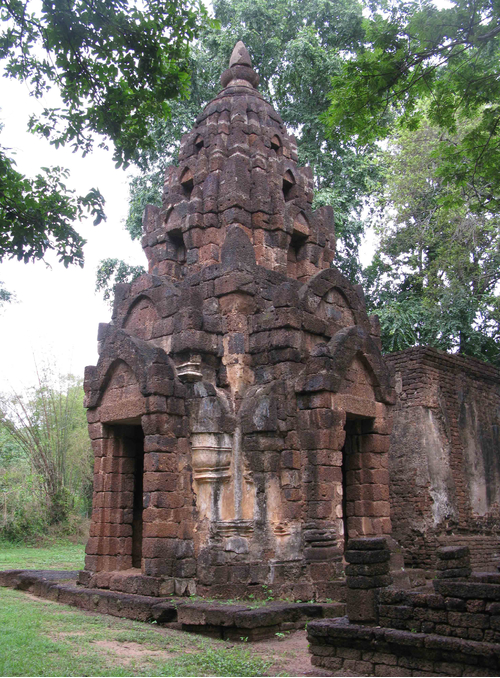ค้นหางานศิลปกรรม
ฐานข้อมูลศิลปกรรมในเอเชียตะวันออกเฉียงใต้
สถาปัตยกรรมเจดีย์ประธาน วัดเชียงงาสง่างาม
เจดีย์องค์นี้เป็นเจดีย์ทรงระฆัง ส่วนฐานเป็นบัวถลาในผังยกเก็จต่อด้วยบัวคลุ่ม องค์ระฆังในผังกลมมีการประดับบัวคอเสื้อ ส่วนยอดทำเป็นเจดีย์จำลอง
สถาปัตยกรรมศาลตาผาแดง
เป็นปราสาทแบบเขมรก่อด้วยศิลาแลงขนาดใหญ่ที่นิยมใช้ในงานก่อสร้างในวัฒนธรรมเขมร ส่วนยอดพังทลายไปแล้ว เหลือแต่ส่วนห้องที่เคยประดิษฐานรูปเคารพกับมุขทางเข้าที่เชื่อมต่อ หันหน้าไปทางทิศตะวันออก ส่วนล่างของอาคารเริ่มจากชั้นเขียงรองรับฐานบัวลูกฟัก เหนือจากฐานขึ้นไปคือเรือนธาตุทรงสี่เหลี่ยมจัตุรัสเพิ่มมุม และต่อมุขออกไปทางตะวันออก โดยมีบันไดทางขึ้นอยู่หน้ามุข อันเป็นแบบอย่างของปราสาทเขมรเช่นกัน ซึ่งต่อมาลักษณะดังกล่าวนี้ช่างสุโขทัยจะเลือกนำไปปรับปรุงอยู่ในเจดีย์รูปทรงใหม่ของตน ก่อนหน้านี้คงสร้างขึ้นในศาสนาฮินดูหรือศาสนาพุทธฝ่ายมหายาน ต่อขึ้นไปคือส่วนบนซึ่งพังทลายลงหมดแล้ว เชื่อว่าส่วนบนของปราสาทเป็นทรงแท่ง มีชั้นซ้อนเช่นเดียวกับปราสาทเขมรโดยทั่วไป
สถาปัตยกรรมโบราณสถานดงเมืองเตย
ปัจจุบันเหลือเพียงฐานอาคาร ก่ออิฐไม่สอปูนในผังสี่เหลี่ยมผืนผ้า ฐานอาคารประกอบด้วยฐานเขียง 4 ชั้น ถัดขึ้นมาเป็นฐานบัวอันประกอบด้วยหน้ากระดานล่าง บัวคว่ำ ถัดขึ้นไปเป็นท้องไม้ ซึ่งมีการแบ่งเป็นช่องสี่เหลี่ยมผืนผ้า ภายในมีลวดลายเป็นรูปสี่เหลี่ยมจัตุรัสขนาดเล็กซ้อนกัน 3 ชั้น เหนือขึ้นไปเป็นบัวหงาย ซึ่งเรียกว่าบัวรวน และหน้ากระดานบนอาคารหลังนี้หันหน้าไปทางทิศตะวันออก โดยฐานเขียงชั้นที่ 1 และ 2 มีการก่ออิฐเป็นแนวยื่นออกมาทางทิศตะวันออก และมีการย่อมุมโดยฐานเขียงชั้นที่ 1 ย่อมุม 3 ช่วง ฐานเขียงชั้นที่ 2 ย่อมุม 2 ช่วง บริเวณริมทั้ง 2 มีร่องรอยของหลุมเสากลม โดยฐานเขียงชั้นที่ 1 มีรอยหลุมเสา 2 คู่ ฐานเขียงชั้นที่ 2 มีรอยหลุมเสา 1 คู่ทางด้านเหนือและตะวันออกของด้านข้างของฐานเขียงชั้นที่ 1 ที่ยื่นออกมาทางทิศตะวันออก มีลวดลายช่องสี่เหลี่ยมขนาดเล็กอยู่ภายในช่องสี่เหลี่ยมที่มีขนาดใหญ่เรียงกัน 1 แถวบริเวณทางขึ้นด้านทิศตะวันออกติดกับฐานเขียงชั้นที่ 1 มีอัฒจันทร์ก่อเป็นรูปปีกกา 1 ชั้น ต่อจากอัฒจันทร์มีการก่ออิฐเป็นลายทางเดินด้านหน้า ยาวประมาณ 28 เมตร ช่วงระหว่างกลางลานด้านหน้ามีการก่ออิฐเป็นรูปสี่เหลี่ยมหลายชั้น ตรงกลางจะสูงกว่าส่วนอื่น รายละเอียดส่วนฐานของโบราณสถานดงเมืองเตยที่กล่าวมานี้จึงมีลักษณะร่วมสามารถเทียบได้กับฐานของโบราณสถานในเมืองสมโบร์ไพรกุก ประเทศกัมพูชา และฐานเรือนธาตุของเจดีย์จุลประโทน นครปฐม ซึ่งเป็นโบราณสถานในศิลปะทวารวดี
สถาปัตยกรรมปรางค์ศรีเทพ
โบราณสถานปรางค์ศรีเทพประกอบด้วยปราสาทประธาน บรรณาลัย โคปุระ กำแพง ชานชาลาหรือทางเดินรูปกากบาท สะพานนาค และอาคารรูปสี่เหลี่ยมผืนผ้าที่ทอดยาวขนานกับสะพานนาคปราสาทประธานเป็นปราสาทอิฐในผังสี่เหลี่ยมเพิ่มมุม ตั้งอยู่บนฐานบัวลูกฟักสองชั้นก่อด้วยศิลาแลง ประตูทางเข้าอยู่ทางด้านทิศตะวันออก ที่เหลืออีกสามด้านเป็นประตูหลอก ภายในของประตูหลอกทำเป็นช่องหรือซุ้มที่ประดิษฐานประติมากรรมรูปเคารพปัจจุบันตัวปราสาทไม่เหลือร่องรอยหรือชิ้นส่วนประดับสถาปัตยกรรม เดิมคงมีหลังคาเครื่องไม้คลุมที่ด้านหน้าอาคารเนื่องจากที่พื้นของฐานบัวลูกฟักชั้นล่างพบร่องรอยหลุมเสากลมขนาดใหญ่ และกระเบื้องมุงหลังคาดินเผาเป็นจำนวนมาก จากหลักฐานโบราณวัตถุที่พบในบริเวณปรางค์ศรีเทพได้แก่ เทวรูปพระอิศวร 4 กร จึงกำหนดอายุปรางค์ศรีเทพอยู่ในราวพุทธศตวรรษที่ 16-17
สถาปัตยกรรมปรางค์สองพี่น้อง
รูปแบบสถาปัตยกรรมเป็นปราสาทเขมร ก่อด้วยอิฐไม่สอปูน มีร่องรอยปูนฉาบที่ผนังด้านนอก แผนผังประกอบด้วยปราสาทสองหลังตั้งอยู่ใกล้กันในแนวเหนือ-ใต้บนฐานไพทีเดียวกัน ปราสาททั้งสองหลังหันหน้าไปทางทิศตะวันตก โดยปราสาทหลังใหญ่ที่ตั้งอยู่ทางทิศเหนือของปราสาทองค์เล็กในแผนผังสี่เหลี่ยมเพิ่มมุม มีมุขยื่นออกมาทางด้านทิศตะวันตกซึ่งเป็นช่องประตูทางเข้า อีกสามด้านที่เหลือเป็นประตูหลอก ที่ด้านหน้ามุขปราสาทมีฐานศิลาแลงรูปกากบาท ส่วนหลังคาพังทลายจนไม่เห็นรูปทรง แต่จากการขุดแต่งพบกลีบมะเฟืองประดับหลังคาสลักจากศิลาแลง จึงสันนิษฐานว่าส่วนบนคงทำเป็นเรือนซ้อนชั้นลดหลั่นกันขึ้นไป แต่ละชั้นประดับด้วยนาคปักจนถึงส่วนยอดที่เป็นกลศ รูปทรงโดยรวมของส่วนบนคงเป็นทรงพุ่มเช่นเดียวกับปราสาทหินพิมายหรือพนมรุ้ง อันเป็นพัฒนาการของปราสาทเขมรที่สำคัญในช่วงพุทธศตวรรษที่ 16ปราสาทหลังเล็กทางด้านทิศใต้ แต่เดิมเหลือเพียงส่วนของเรือนธาตุช่วงล่างแต่ได้ซ่อมแซมต่อเติมขึ้นไปเพื่อติดตั้งทับหลังที่พบในบริเวณเดียวกัน วัสดุ และรูปทรงโดยรวมเหมือนกับปราสาทองค์ใหญ่ แต่ได้ลดความซับซ้อนของส่วนฐานและการซ้อนชั้นของเรือนธาตุลง และไม่ได้ก่อมุขยื่นออกมาทางด้านหน้า โบราณวัตถุชิ้นสำคัญที่พบบริเวณปรางค์สองพี่น้อง ได้แก่ ศิวลึงค์ ฐานโยนิ และโคนนทิ ฝังอยู่ใต้ดินในระดับฐานอาคาร จึงสันนิษฐานว่าเดิมปรางค์สองพี่น้องคงเป็นเทวสถานในศาสนาพราหมณ์ไศวนิกาย ซึ่งอาจกำหนดอายุได้ในราวพุทธศตวรรษที่ 17 จากทับหลังและเสาประดับกรอบประตูรูปแบบศิลปะเขมรแบบบาปวนที่พบจากการขุดแต่ง
สถาปัตยกรรมกุฏิฤาษีบ้านโคกเมือง
แผนผังรูปสี่เหลี่ยมผืนผ้า ด้านนอกสุดเป็นกำแพงศิลาแลงมีซุ้มประตูทางเข้าหรือโคปุระทางทิศตะวันออก ตรงกลางภายในเป็นที่ตั้งของปราสาทประธานก่อด้วยศิลาแลง บางตอนมีหินทรายประกอบกรอบประตู ประตูด้านหน้าทางทิศตะวันออกทำเป็นมุขยื่นออกมา ประตูอีก 3 ด้านเป็นประตูหลอก ส่วนทางด้านทิศตะวันออกเฉียงใต้ของปราสาทประธานภายในกำแพงแก้วเป็นบรรณาลัยก่อด้วยศิลาแลงเช่นเดียวกัน บางส่วนของโคปุระและปราสาทประธานมีการประดับด้วยส่วนประกอบของหน้าบันหรือทับหลังเป็นรูปนาค มกรคายนาค สันนิษฐานว่าเป็นรูปแบบศิลปะในราวพุทธศตวรรษที่ 16-17 แต่ทว่าส่วนประดับเหล่านี้ดูไม่สู้จะต่อเนื่องกับปราสาทประธานและกำแพง จึงอาจเป็นการนำของเดิมมาประกอบอาคารที่ก่อสร้างใหม่ อย่างไรก็ตาม หากชิ้นส่วนประดับสถาปัตยกรรมเหล่านี้เป็นของที่มีมาแต่เดิม ก็อาจสันนิษฐานว่าเคยมีศาสนสถานแห่งหนึ่งสร้างขึ้นในราวพุทธศตวรรษที่ 16 ต่อมาในพุทธศตวรรษที่ 18 จึงปรับเปลี่ยนใช้เป็นอโรคยศาลในพุทธศาสนามหายาน
สถาปัตยกรรมวัดศรีสวาย
ตั้งหันหน้าไปทางทิศใต้ มีกำแพงศิลาแลงล้อมรอบเป็นรูปสี่เหลี่ยมผืนผ้า กึ่งกลางกำแพงด้านทิศใต้มีซุ้มประตูเข้าออก 1 แห่ง ถัดเข้าไปเป็นวิหารโถงชั้นนอกต่อเนื่องด้วยวิหารทึบชั้นในในแนนวเหนือใต้ ถัดจากนั้นเป็นปราสาท 3 หลังเรียงกันในแนวตะวันตก-ตะวันออก หลังกลางสูงกว่าหลังที่ขนาบทั้งสองข้าง สภาพปัจจุบันแสดงให้เห็นร่องรอยการก่อสร้างและดัดแปลงมาแล้วหลายครั้ง ส่วนฐานนั้นจมดินอยู่ ก่อด้วยศิลาแลงมาจนถึงเรือนธาตุ แต่ส่วนหลังคาที่ซ้อนเป็นชั้นก่อด้วยอิฐ ประดับกลีบขนุนรูปครุฑยุดนาค เทวดา อัปสร นาคโคนกรอบซุ้ม ซึ่งคลี่คลายจากศิลปะเขมรผสมผสากับศิลปะสุโขทัย นอกจากนี้ยังมีร่องรอยสิ่งก่อสร้างอื่นๆ ได้แก่ แนวระเบียงล้อมรอบปราสาท ฐานอาคาร 3 หลังกระจายล้อมรอบปราสาทประธานพื้นที่ระหว่างกำแพงวัดและกำแพงแก้วมีสระน้ำอยู่ด้านหลังปราสาท ซึ่งในอดีตน่าจะเป็นรูปตัว U คว่ำ ต่อมาได้มีการถมบริเวณทิศตะวันตกและปรากฏวิหารน้อยก่อด้วยศิลาแลง 1 หลัง ด้านหน้าวิหารน้อยปรากฏฐานเจดีย์ 1 องค์ ส่วนด้านหลังกำแพงวัดด้านทิศเหนือยังปรากฏฐานอาคารก่อด้วยศิลาแลง 1 หลัง โบราณวัตถุชิ้นสำคัญที่ค้นพบได้ในวัด ได้แก่ ทับหลังนารายณ์บรรทมสินธุ์ แผ่นหินสลักรูปพระนารายณ์ประทับยืน พระพุทธรูปสำริดทรงเครื่อง กำหนดอายุในราวพุทธศตวรรษที่ 18 จึงสันนิษฐานว่าเมื่อแรกสร้างวัดศรีสวายนี้เพื่อเป็นศาสนสถานในศาสนาพราหมณ์หรือพุทธมหายาน ต่อมาเมื่อสุโขทัยมีอำนาจเหนือขอมในพุทธศตวรรษที่ 19 จึงได้มีการปรับเปลี่ยนเป็นศาสนสถานพุทธเถรวาท
สถาปัตยกรรมปราสาทวัดเจ้าจันทร์
ประกอบด้วยปราสาทประธานก่อด้วยศิลาแลง มีแผนผังรูปสี่เหลี่ยมจัตุรัสออกมุม และมีปูนฉาบประดับตกแต่งผิว ฐานชั้นล่างสุดเป็นชุดบัวคว่ำ-บัวหงาย ที่เรือนธาตุมีซุ้มประกอบทั้งสี่ด้าน มีประตูทางเข้าด้านหน้าทางทิศตะวันออกเพียงทางเดียวด้านหน้ามีห้องสำหรับประดิษฐานรูปเคารพ ส่วนด้านอื่นๆ ตกแต่งเป็นประตูหลอก ถัดขึ้นไปเป็นชุดเครื่องบนของปราสาทสอบคล้ายรูปพุ่มและมีกลศประดับเป็นเครื่องยอด ต่อมาในสมัยสุโขทัย ศาสนสถานแห่งนี้ได้รับการปรับเปลี่ยนให้เป็นวัดทางพระพุทธศาสนา โดยการถมบริเวณโดยรอบของฐานปราสาท ทำให้ฐานชุดบัวคว่ำ-บัวหงายจมอยู่ใต้ดิน แล้วจึงสร้างวิหารศิลาแลงขึ้นที่ด้านหน้าของปรางค์ปราสาทพร้อมกับมณฑปศิลาแลงสำหรับประดิษฐานพระอัฏฐารศขึ้นทางทิศเหนือของปรางค์ ในมณฑปมีโกลนศิลาแลงพระพุทธรูปยืนพระหัตถ์แนบลำพระองค์ ๑ องค์ หลังคาที่เป็นเครื่องไม้ได้ผุพังไป พบเพียงชิ้นส่วนของกระเบื้องดินเผาสำหรับมุงหลังคาตกกระจายอยู่โดยรอบ ต่อมากรมศิลปากรได้ขุดพบพระพิมพ์ทำด้วยชิน ทรงเครื่องแบบกษัตริย์ และเมื่อขุดลึกลงไปอีกในระดับลึกพบโบราณวัตถุสมัยทวารวดี เครื่องถ้วยหริภุญไชย ลูกปัดแก้ว และชิ้นส่วนโครงกระดูกคน
